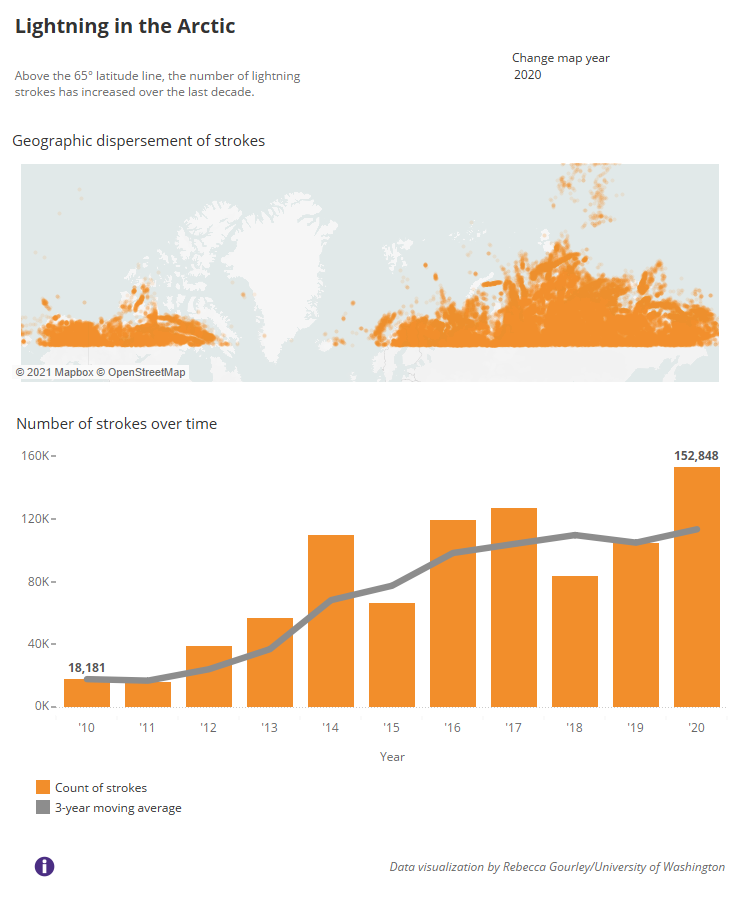22 March 2021

Lightning strikes above 65 degrees latitude have increased over the last decade. Click for interactive map.
Credit: University of Washington
AGU press contact:
Liza Lester, +1 (202) 777-7494, [email protected] (UTC -4:00 hours)
University of Washington press contact
Hannah Hickey, +1 (206) 616-7164, [email protected] (UTC -7:00 hours)
Contact information for the researchers:
Bob Holzworth, University of Washington, Seattle, [email protected] (UTC -7:00 hours)
WASHINGTON—Lightning strikes in the Arctic tripled from 2010 to 2020, a finding researchers attribute to rising temperatures due to human-caused climate change. The results suggest Arctic residents in northern Russia, Canada, Europe and Alaska need to prepare for the danger of more frequent lightning strikes, according to the researchers.
A new study in Geophysical Research Letters, AGU’s journal publishing high-impact, short-format reports with immediate implications spanning all Earth and space sciences, used data from the World Wide Lightning Location Network (WWLLN) to map lightning strikes across the globe from 2010 to 2020 (interactive graphic). WWLLN sensors detect the short burst of radio waves emitted during a lightning strike.
Lightning in the Arctic is historically rare, as it usually isn’t warm enough to generate the right thunderstorm conditions during which lightning occurs. But researchers have recently noticed more strikes occurring in the northernmost latitudes and they even reported several lightning strikes near the north pole in August 2019. Lightning strikes that do occur in the Arctic tend to happen in the summer when thunderstorms are most likely to form.
The new study found the number of lightning strikes above 65 degrees north latitude during the summer months tripled from 2010 to 2020 as compared to the total number of lightning strikes over the entire globe during the same period.
The Arctic is warming faster than any other region on Earth, and the study authors found the uptick in lightning strikes matched rising temperatures in the region over the past decade. Arctic temperatures increased by 0.3 degrees Celsius from 2010 to 2020; that warming has created more favorable conditions for intense summer thunderstorms that produce lightning, according to the authors.
Arctic sea ice is declining by about 13% every decade, according to NASA. Less ice means more ocean routes will be available for shipping through the Arctic, especially in the summer months. Countries like Russia, China, Canada and the United States are already preparing to use the Arctic Ocean as a viable shipping route in the future.
Arctic sea ice minima, 1979-2020. Visualization Credit: NASA.
The new study suggests shipping vessels throughout the Arctic could be more vulnerable to lightning strikes, in addition to those who call the Arctic home.
“With long periods of ice-free ocean and increasing shipping in the Arctic, you’re going to have the same problem you have at lower latitudes: when there’s a lot of people and they don’t know about the lightning threat and it becomes a problem,” said Bob Holzworth, an atmospheric and space physicist at the University of Washington in Seattle and lead author of the new study.
In the new study, Holzworth and his colleagues analyzed the frequency of Arctic lightning strikes occurring during the summer months of June, July and August from 2010 to 2020. They found the percentage of lightning strikes occurring in the Arctic tripled from 0.2% of global lightning strikes in 2010 to 0.6% in 2020. The actual number of lightning strikes above 65 degrees north increased from about 18,000 in 2010 to over 150,000 in 2020.
During the same time period, Arctic temperatures increased from 0.65 to 0.95 degrees Celsius above pre-industrial times. Holzworth and his colleagues attribute the increased lightning strikes to these rising temperatures, as warmer summers mean more chances for intense thunderstorms to develop and create lightning.
###
AGU (www.agu.org) supports 130,000 enthusiasts to experts worldwide in Earth and space sciences. Through broad and inclusive partnerships, we advance discovery and solution science that accelerate knowledge and create solutions that are ethical, unbiased and respectful of communities and their values. Our programs include serving as a scholarly publisher, convening virtual and in-person events and providing career support. We live our values in everything we do, such as our net zero energy renovated building in Washington, D.C. and our Ethics and Equity Center, which fosters a diverse and inclusive geoscience community to ensure responsible conduct.
Notes for Journalists
This research study will be free available for 30 days. Download a PDF copy of the paper here. Neither the paper nor this press release is under embargo.
Paper title:
“Lightning in the Arctic”
Authors:
- Robert Holzworth, corresponding author (University of Washington)
- James Brundell (University of Otago)
- Michael McCarthy (University of Washington)
- Abram Jacobson (University of Washington)
- Craig Rodger (Physics Department)
- Todd Anderson (University of Washington)